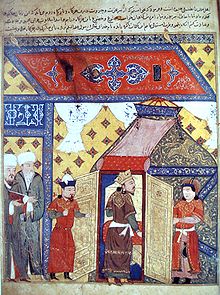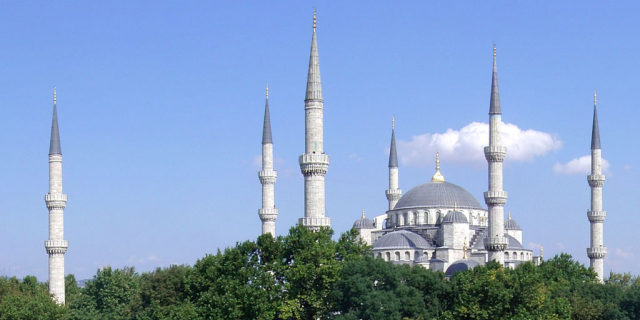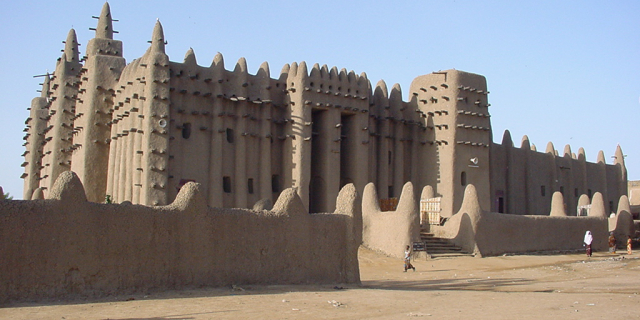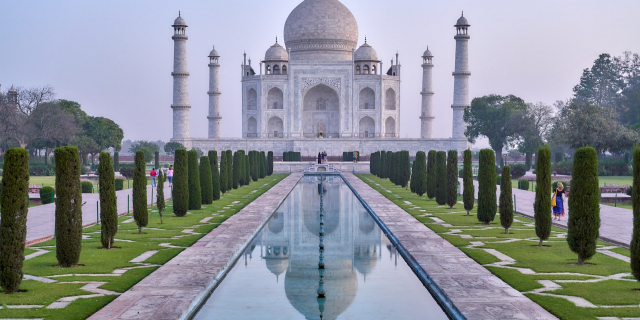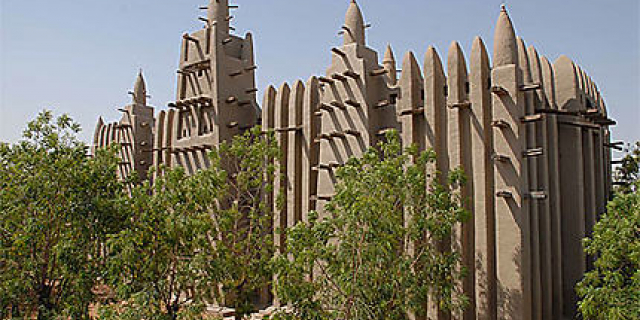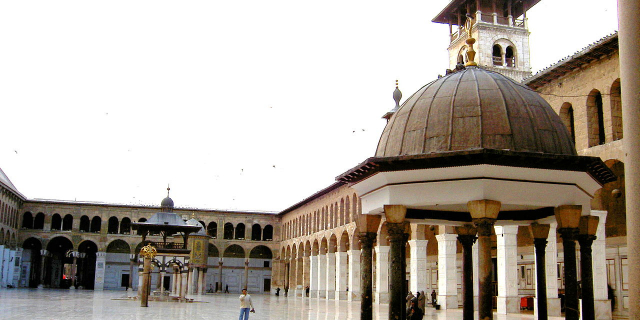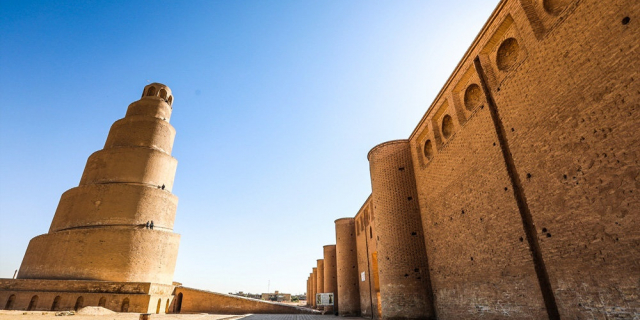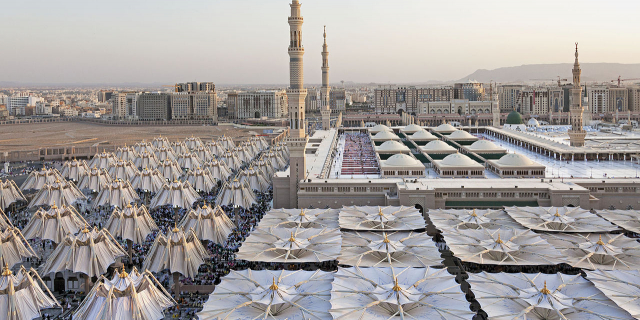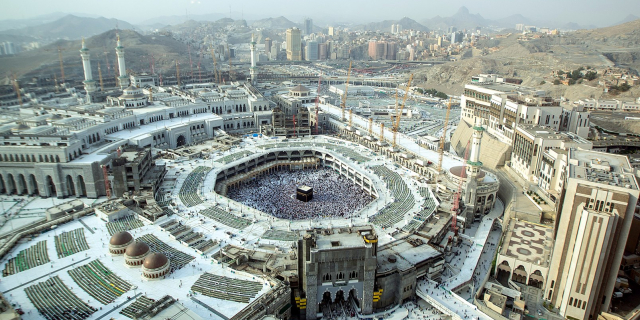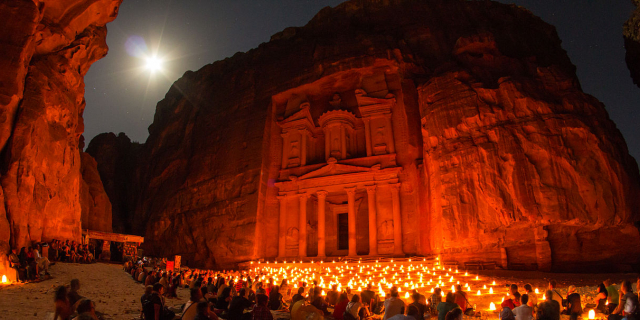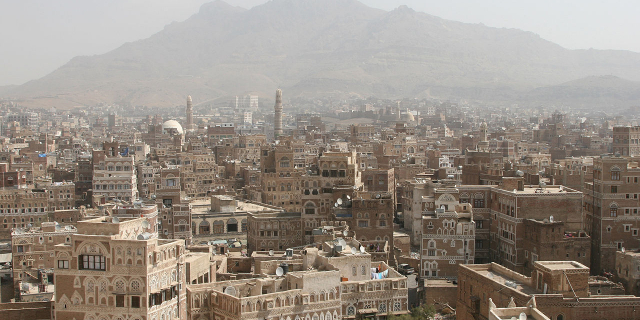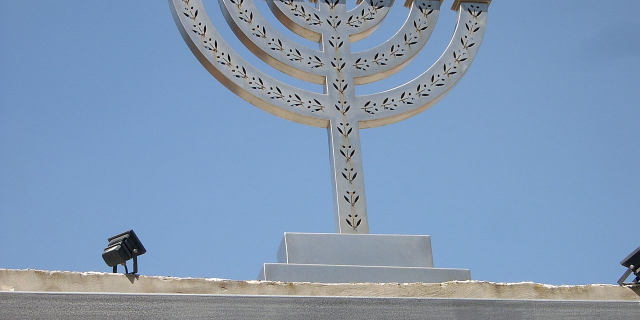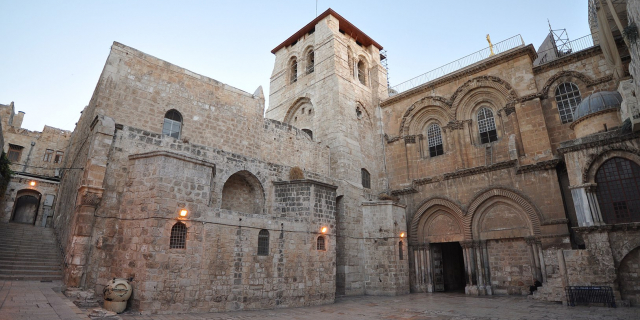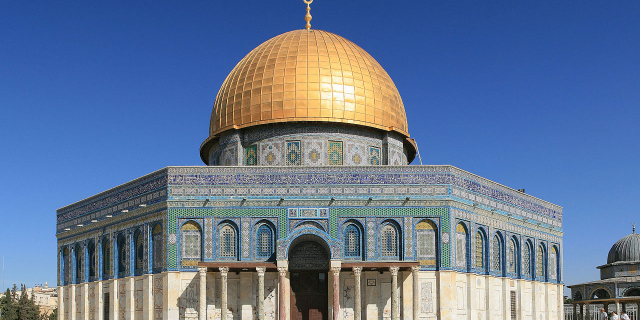Islam
Context of Islam
Islam (; Arabic: ۘالِإسلَام, al-ʾIslām [ɪsˈlaːm] (listen), transl. "Submission [to God]") is an Abrahamic monotheistic religion centered on the Quran and the teachings of Muhammad. Adherents of Islam, called Muslims, number approximately 1.9 billion globally and are the world's second-largest religious population after Christians.
Muslims believe that Islam is the complete and universal version of a primordial faith that was revealed many times through earlier prophets such as Adam (believed to be the first man), Abraham, Moses, and Jesus, among others; these earlier revelations are attributed to Judaism and Christianity, which are regarded in Islam as spiritual predecessor faiths. Muslims consider the Quran to be the verbatim word of God and the unaltered, final revelation. Alongside ...Read more
Islam (; Arabic: ۘالِإسلَام, al-ʾIslām [ɪsˈlaːm] (listen), transl. "Submission [to God]") is an Abrahamic monotheistic religion centered on the Quran and the teachings of Muhammad. Adherents of Islam, called Muslims, number approximately 1.9 billion globally and are the world's second-largest religious population after Christians.
Muslims believe that Islam is the complete and universal version of a primordial faith that was revealed many times through earlier prophets such as Adam (believed to be the first man), Abraham, Moses, and Jesus, among others; these earlier revelations are attributed to Judaism and Christianity, which are regarded in Islam as spiritual predecessor faiths. Muslims consider the Quran to be the verbatim word of God and the unaltered, final revelation. Alongside the Qur'an, Muslims also believe in the previous revelations, such as the Tawrat, the Zabur (Psalms), and the Injeel (Gospel). They also consider Muhammad as the main and final Islamic prophet, through whom the religion was completed. The teachings and normative example of Muhammad, called the sunnah, documented in accounts called the hadith, provide a constitutional model for Muslims. Islam teaches that God (Allah) is one and incomparable. It states that there will be a "Final Judgement" wherein the righteous will be rewarded in paradise (Jannah) and the unrighteous will be punished in hell (Jahannam). The Five Pillars—considered obligatory acts of worship—comprise the Islamic oath and creed (shahada); daily prayers (salah); almsgiving (zakat); fasting (sawm) in the month of Ramadan; and a pilgrimage (Hajj) to Mecca. Islamic law, sharia, touches on virtually every aspect of life, from banking and finance and welfare to men's and women's roles and the environment. Prominent religious festivals include Eid al-Fitr, and Eid al-Adha. The three holiest sites in Islam in descending order are Masjid al-Haram in Mecca, Al-Masjid an-Nabawi in Medina, and Al-Aqsa Mosque in Jerusalem.
Islam, in its current and final form, originated in the 7th century in Mecca. Muslim rule expanded outside Arabia under the Rashidun Caliphate and the subsequent Umayyad Caliphate ruled from the Iberian Peninsula to the Indus Valley. In the Islamic Golden Age, mostly during the reign of the Abbasid Caliphate, much of the Muslim world experienced a scientific, economic and cultural flourishing. The expansion of the Muslim world involved various states and caliphates as well as extensive trade and religious conversion as a result of Islamic missionary activities (dawah), and through conquests.
There are two major Islamic denominations: Sunni Islam (85–90%) and Shia Islam (10–15%). While Sunni–Shia differences initially arose from disagreements over the succession to Muhammad, they grew to cover a broader dimension, both theologically and juridically. Muslims make up a majority of the population in 49 countries. Approximately 12% of the world's Muslims live in Indonesia, the most populous Muslim-majority country; 31% live in South Asia; 20% live in the Middle East–North Africa; and 15% live in sub-Saharan Africa. Sizable Muslim communities are also present in the Americas, China, and Europe. Due largely to a higher fertility rate, Islam is the world's fastest growing major religious group, and if current trends hold it would slightly surpass Christianity as the world's largest religion by the end of the 21st century.
There are also many other denominations in Sunni such as Deobandis, Barelvis and Ahlul hadith primarily in the Indian subcontinent. Some Sufis also claim to be Sunni.
More about Islam
- Muhammad and the birth of Islam (570–632)Muhammad and the birth of Islam (570–632)Read less
According to Islamic tradition, Muhammad was born in Mecca in 570 CE and was orphaned early in life. Growing up as a trader, he became known as the "trusted one" (Arabic: الامين), [1] and was sought after as an impartial arbitrator. He later married his employer, the businesswoman Khadija.
In the year 610 CE, troubled by the moral decline and idolatry prevalent in Mecca, and seeking seclusion and spiritual contemplation, Muhammad retreated to the Cave of Hira in the mountain Jabal al-Nour, near Mecca. It was during his time in the cave that he is said to have received the first revelation of the Quran from the angel Jibreel.[2] The event of Muhammad's retreat to the cave and subsequent revelation is known as the "Night of Power" (Laylat al-Qadr) and is considered a significant event in Islamic history. During the next 22 years of his life, from age 40 onwards, Muhammad continued to receive revelations from God, becoming the last or seal of the prophets sent to mankind.[3][4][5]
During this time, while in Mecca, Muhammad preached first in secret and then in public, imploring his listeners to abandon polytheism and worship one God. Many early converts to Islam were women, the poor, foreigners, and slaves like the first muezzin Bilal ibn Rabah al-Habashi.[6] The Meccan elite felt Muhammad was destabilizing their social order by preaching about one God and giving questionable ideas to the poor and slaves because they profited from the pilgrimages to the idols of the Kaaba.[7][8][9]
After 12 years of the persecution of Muslims by the Meccans, Muhammad and his companions performed the Hijra ("emigration") in 622 to the city of Yathrib (current-day Medina). There, with the Medinan converts (the Ansar) and the Meccan migrants (the Muhajirun), Muhammad in Medina established his political and religious authority. The Constitution of Medina was signed by all the tribes of Medina establishing among the Muslim and non-Muslim communities religious freedoms and freedom to use their own laws and agreeing to bar weapons from Medina and to defend it from external threats.[10] Meccan forces and their allies lost against the Muslims at the Battle of Badr in 624 and then fought an inconclusive battle in the Battle of Uhud[11] before unsuccessfully besieging Medina in the Battle of the Trench (March–April 627). In 628, the Treaty of Hudaybiyyah was signed between Mecca and the Muslims, but it was broken by Mecca two years later. As more tribes converted to Islam, Meccan trade routes were cut off by the Muslims.[12][13] By 629 Muhammad was victorious in the nearly bloodless conquest of Mecca, and by the time of his death in 632 (at age 62) he had united the tribes of Arabia into a single religious polity.[14]
Early Islamic period (632–750) Rashidun and Umayyad expansion
Rashidun and Umayyad expansion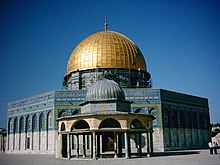 Dome of the Rock built by caliph Abd al-Malik ibn Marwan; completed at the end of the Second Fitna
Dome of the Rock built by caliph Abd al-Malik ibn Marwan; completed at the end of the Second FitnaMuhammad died in 632 and the first successors, called Caliphs – Abu Bakr, Umar, Uthman ibn al-Affan, Ali ibn Abi Talib and sometimes Hasan ibn Ali[15] – are known in Sunni Islam as al-khulafā' ar-rāshidūn ("Rightly Guided Caliphs").[16] Some tribes left Islam and rebelled under leaders who declared themselves new prophets but were crushed by Abu Bakr in the Ridda wars.[17][18][19][20][21] Local populations of Jews and indigenous Christians, persecuted as religious minorities and heretics and taxed heavily, often helped Muslims take over their lands,[22] resulting in rapid expansion of the caliphate into the Persian and Byzantine empires.[23][24] Uthman was elected in 644 and his assassination by rebels led to Ali being elected the next Caliph. In the First Civil War, Muhammad's widow, Aisha, raised an army against Ali, asking to avenge the death of Uthman, but was defeated at the Battle of the Camel. Ali attempted to remove the governor of Syria, Mu'awiya, who was seen as corrupt. Mu'awiya then declared war on Ali and was defeated in the Battle of Siffin. Ali's decision to arbitrate angered the Kharijites, an extremist sect, who felt that by not fighting a sinner, Ali became a sinner as well. The Kharijites rebelled and were defeated in the Battle of Nahrawan but a Kharijite assassin later killed Ali. Ali's son, Hasan ibn Ali, was elected Caliph and signed a peace treaty to avoid further fighting, abdicating to Mu'awiya in return for Mu'awiya not appointing a successor.[25] Mu'awiya began the Umayyad dynasty with the appointment of his son Yazid I as successor, sparking the Second Civil War. During the Battle of Karbala, Husayn ibn Ali was killed by Yazid's forces; the event has been annually commemorated by Shias ever since. Sunnis, led by Ibn al-Zubayr, opposed to a dynastic caliphate were defeated in the siege of Mecca. These disputes over leadership would give rise to the Sunni-Shia schism,[26] with the Shia believing leadership belongs to Muhammad's family through Ali, called the ahl al-bayt.[27]
Abu Bakr's leadership oversaw the beginning of the compilation of the Qur'an. The Caliph Umar ibn Abd al-Aziz set up the committee, The Seven Fuqaha of Medina,[28][29] and Malik ibn Anas wrote one of the earliest books on Islamic jurisprudence, the Muwatta, as a consensus of the opinion of those jurists.[30][31][32] The Kharijites believed there is no compromised middle ground between good and evil, and any Muslim who commits a grave sin becomes an unbeliever. The term is also used to refer to later groups such as Isis.[33] The Murji'ah taught that people's righteousness could be judged by God alone. Therefore, wrongdoers might be considered misguided, but not denounced as unbelievers.[34] This attitude came to prevail into mainstream Islamic beliefs.[35]
The Umayyad dynasty conquered the Maghreb, the Iberian Peninsula, Narbonnese Gaul and Sindh.[36] The Umayyads struggled with a lack of legitimacy and relied on a heavily patronized military.[37] Since the jizya tax was a tax paid by non-Muslims which exempted them from military service, the Umayyads denied recognizing the conversion of non-Arabs as it reduced revenue.[35] While the Rashidun Caliphate emphasized austerity, with Umar even requiring an inventory of each official's possessions,[38] Umayyad luxury bred dissatisfaction among the pious.[35] The Kharijites led the Berber Revolt leading to the first Muslim states independent of the Caliphate. In the Abbasid revolution, non-Arab converts (mawali), Arab clans pushed aside by the Umayyad clan, and some Shi'a rallied and overthrew the Umayyads, inaugurating the more cosmopolitan Abbasid dynasty in 750.[39][40]
Classical era (750–1258)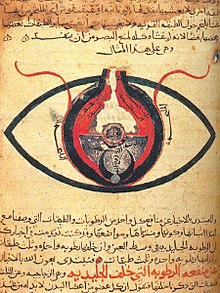 The eye, according to Hunain ibn Ishaq from a manuscript dated c. 1200
The eye, according to Hunain ibn Ishaq from a manuscript dated c. 1200Al-Shafi'i codified a method to determine the reliability of hadith.[41] During the early Abbasid era, scholars such as Muhammad al-Bukhari and Muslim ibn al-Hajjaj compiled the major Sunni hadith collections while scholars like Al-Kulayni and Ibn Babawayh compiled major Shia hadith collections. The four Sunni Madh'habs, the Hanafi, Hanbali, Maliki, and Shafi'i, were established around the teachings of Abū Ḥanīfa, Ahmad ibn Hanbal, Malik ibn Anas and al-Shafi'i. In contrast, the teachings of Ja'far al-Sadiq formed the Ja'fari jurisprudence. In the 9th century Al-Tabari completed the first commentary of the Quran, that became one of the most cited commentaries in Sunni Islam, the Tafsir al-Tabari. Some Muslims began questioning the piety of indulgence in worldly life and emphasized poverty, humility, and avoidance of sin based on renunciation of bodily desires. Ascetics such as Hasan al-Basri would inspire a movement that would evolve into tasawwuf or sufism.[42][43]
At this time, theological problems, notably on free will, were prominently tackled, with Hasan al Basri holding that although God knows people's actions, good and evil come from abuse of free will and the devil.[44][a] Greek rationalist philosophy influenced a speculative school of thought known as Muʿtazila, who famously advocated the notion of free-will, first originated by Wasil ibn Ata.[46] Caliphs such as Mamun al Rashid and Al-Mu'tasim made it an official creed and unsuccessfully attempted to force their position on the majority.[47] They carried out inquisitions with the traditionalist Ahmad ibn Hanbal notably refusing to conform to the Muʿtazila idea that the Quran was created rather than being eternal and was tortured and kept in an unlit prison cell for nearly thirty months.[48] However, other schools of speculative theology – Māturīdism founded by Abu Mansur al-Maturidi and Ash'ari founded by Al-Ash'ari – were more successful in being widely adopted. Philosophers such as Al-Farabi, Avicenna and Averroes sought to harmonize Aristotle's ideas with the teachings of Islam, similar to later scholasticism within Christianity in Europe and Maimonides' work within Judaism, while others like Al-Ghazali argued against such syncretism and ultimately prevailed.[49][50]
This era is sometimes called the "Islamic Golden Age".[51][52][53][54][24] Islamic scientific achievements encompassed a wide range of subject areas especially medicine, mathematics, astronomy, agriculture as well as physics, economics, engineering and optics.[55][56][57][58] Avicenna was a pioneer in experimental medicine,[59][60] and his The Canon of Medicine was used as a standard medicinal text in the Islamic world and Europe for centuries. Rhazes was the first to distinguish the diseases smallpox and measles.[61] Public hospitals of the time issued the first medical diplomas to license doctors.[62][63] Ibn al-Haytham is regarded as the father of the modern scientific method and often referred to as the "world's first true scientist", in particular regarding his work in optics.[64][65][66][67] In engineering, the Banū Mūsā brothers' automatic flute player is considered to have been the first programmable machine.[68] In mathematics, the concept of the algorithm is named after Muhammad ibn Musa al-Khwarizmi, who is considered a founder of algebra, which is named after his book al-jabr,[69] while others developed the concept of a function.[70] The government paid scientists the equivalent salary of professional athletes today.[71] The Guinness World Records recognizes the University of Al Karaouine, founded in 859, as the world's oldest degree-granting university.[72] Many non-Muslims, such as Christians, Jews and Sabians,[73] contributed to the Islamic civilization in various fields,[74][75] and the institution known as the House of Wisdom employed Christian and Persian scholars to both translate works into Arabic and to develop new knowledge.[76][73]
Soldiers broke away from the Abbasid empire and established their own dynasties, such as the Tulunids in 868 in Egypt[77] and the Ghaznavid dynasty in 977 in Central Asia.[78] In this fragmentation came the Shi'a Century, roughly between 945 and 1055, which saw the rise of the millennialist Isma'ili Shi'a missionary movement. One Isma'ili group, the Fatimid dynasty, took control of North Africa in the 10th century[79] and another Isma'ili group, the Qarmatians, sacked Mecca and stole the Black Stone, a rock placed within the Kaaba, in their unsuccessful rebellion.[80] Yet another Isma'ili group, the Buyid dynasty, conquered Baghdad and turned the Abbasids into a figurehead monarchy. The Sunni Seljuk dynasty, campaigned to reassert Sunni Islam by promulgating the accumulated scholarly opinion of the time notably with the construction of educational institutions known as Nezamiyeh, which are associated with Al-Ghazali and Saadi Shirazi.[81]
The expansion of the Muslim world continued with religious missions converting Volga Bulgaria to Islam. The Delhi Sultanate reached deep into the Indian Subcontinent and many converted to Islam,[82][83] in particular low-caste Hindus whose descendents make up the vast majority of Indian Muslims.[84] Trade brought many Muslims to China and they virtually dominated the import and export industry of the Song dynasty[85] and Muslims were recruited as a governing minority class in the Yuan dynasty.[86]
Pre-Modern era (1258–18th century)Ghazan Khan, 7th Ilkhanate ruler of the Mongol Empire, converts to Islam. 14th-century depictionThrough Muslim trade networks and the activity of Sufi orders, Islam spread into new areas[87][88] and Muslims assimilated into new cultures. Under the Ottoman Empire, Islam spread to Southeast Europe.[89] Conversion to Islam often involved a degree of syncretism,[90] as illustrated by Muhammad's appearance in Hindu folklore.[91] Muslim Turks incorporated elements of Turkish Shamanism beliefs to Islam.[b][93] Muslims in Ming Dynasty China who were descended from earlier immigrants were assimilated, sometimes through laws mandating assimilation,[94] by adopting Chinese names and culture while Nanjing became an important center of Islamic study.[95][96]
Cultural shifts were evident with the decrease in Arab influence after the Mongol destruction of the Abbasid Caliphate.[97] The Muslim Mongol Khanates in Iran and Central Asia benefited from increased cross-cultural access to East Asia under Mongol rule and thus flourished and developed more distinctively from Arab influence, such as the Timurid Renaissance under the Timurid dynasty.[98] Nasir al-Din al-Tusi (1201–1274) proposed the mathematical model that was later adopted by Copernicus unrevised in his heliocentric model, and Jamshīd al-Kāshī's estimate of pi would not be surpassed for 180 years.[99]
The introduction of gunpowder weapons led to the rise of large centralized states and the Muslim gunpowder empires consolidated much of the previously splintered territories. The caliphate was claimed by the Ottoman dynasty of the Ottoman Empire since Murad I's conquest of Edirne in 1362,[100] and its claims were strengthened in 1517 as Selim I became the ruler of Mecca and Medina.[101] The Shia Safavid dynasty rose to power in 1501 and later conquered all of Iran.[102] In South Asia, Babur founded the Mughal Empire.[103]
The religion of the centralized states of the gunpowder empires influenced the religious practice of their constituent populations. A symbiosis between Ottoman rulers and Sufism strongly influenced Islamic reign by the Ottomans from the beginning. The Mevlevi Order and Bektashi Order had a close relation to the sultans,[104] as Sufi-mystical as well as heterodox and syncretic approaches to Islam flourished.[105][106] The often forceful Safavid conversion of Iran to the Twelver Shia Islam of the Safavid Empire ensured the final dominance of the Twelver sect within Shia Islam. Persian migrants to South Asia, as influential bureaucrats and landholders, help spread Shia Islam, forming some of the largest Shia populations outside Iran.[107] Nader Shah, who overthrew the Safavids, attempted to improve relations with Sunnis by propagating the integration of Twelverism into Sunni Islam as a fifth madhhab, called Ja'farism,[108] which failed to gain recognition from the Ottomans.[109]
Modern era (18th–20th centuries) Abdülmecid II was the last Caliph of Islam from the Ottoman dynasty.
Abdülmecid II was the last Caliph of Islam from the Ottoman dynasty.Earlier in the 14th century, Ibn Taymiyya promoted a puritanical form of Islam,[110] rejecting philosophical approaches in favor of simpler theology[110] and called to open the gates of itjihad rather than blind imitation of scholars.[111] He called for a jihad against those he deemed heretics[112] but his writings only played a marginal role during his lifetime.[113] During the 18th century in Arabia, Muhammad ibn 'Abd al-Wahhab, influenced by the works of Ibn Taymiyya and Ibn al-Qayyim, founded a movement, called Wahhabi with their self-designation as Muwahiddun, to return to what he saw as unadultered Islam.[114][115] He condemned many local Islamic customs, such as visiting the grave of Muhammad or saints, as later innovations and sinful[115] and destroyed sacred rocks and trees, Sufi shrines, the tombs of Muhammad and his companions and the tomb of Husayn at Karbala, a major Shia pilgrimage site.[116][117] He formed an alliance with the Saud family, which, by the 1920s, completed their conquest of the area that would become Saudi Arabia.[118] Ma Wanfu and Ma Debao promoted salafist movements in the 19th century such as Sailaifengye in China after returning from Mecca but were eventually persecuted and forced into hiding by Sufi groups.[119] Other groups sought to reform Sufism rather than reject it, with the Senusiyya and Muhammad Ahmad both waging war and establishing states in Libya and Sudan respectively.[120] In India, Shah Waliullah Dehlawi attempted a more conciliatory style against Sufism and influenced the Deobandi movement.[121] In response to the Deobandi movement, the Barelwi movement was founded as a mass movement, defending popular Sufism and reforming its practices.[122][123]
The Muslim world was generally in political decline starting the 1800s, especially regarding non-Muslim European powers. Earlier, in the 15th century, the Reconquista succeeded in ending the Muslim presence in Iberia. By the 19th century, the British East India Company had formally annexed the Mughal dynasty in India.[124] As a response to Western Imperialism, many intellectuals sought to reform Islam.[125] Islamic modernism, initially labelled by Western scholars as Salafiyya, embraced modern values and institutions such as democracy while being scripture-oriented.[126][127] Notable forerunners include Muhammad 'Abduh and Jamal al-Din al-Afghani.[128] Abul A'la Maududi helped influence modern political Islam.[129] Similar to contemporary codification, Shariah was for the first time partially codified into law in 1869 in the Ottoman Empire's Mecelle code.[130]
The Ottoman Empire disintegrated after World War I and the Caliphate was abolished in 1924[131] by the first President of the Turkish Republic, Mustafa Kemal Atatürk, as part of his secular reforms.[132][133] Pan-Islamists attempted to unify Muslims and competed with growing nationalist forces, such as pan-Arabism. The Organisation of Islamic Cooperation (OIC), consisting of Muslim-majority countries, was established in 1969 after the burning of the Al-Aqsa Mosque in Jerusalem.[134]
Contact with industrialized nations brought Muslim populations to new areas through economic migration. Many Muslims migrated as indentured servants (mostly from India and Indonesia) to the Caribbean, forming the largest Muslim populations by percentage in the Americas.[135] Migration from Syria and Lebanon was the biggest contributor to the Muslim population in Latin America. The resulting urbanization and increase in trade in sub-Saharan Africa brought Muslims to settle in new areas and spread their faith, likely doubling its Muslim population between 1869 and 1914.[136]
Contemporary era (20th century–present) Leaders of Muslim countries during session of the Islamic Summit Conference in Istanbul, Turkey
Leaders of Muslim countries during session of the Islamic Summit Conference in Istanbul, TurkeyForerunners of Islamic modernism influenced Islamist political movements such as the Muslim Brotherhood and related parties in the Arab world,[137][138] which performed well in elections following the Arab Spring,[139] Jamaat-e-Islami in South Asia and the AK Party, which has democratically been in power in Turkey for decades. In Iran, revolution replaced a secular monarchy with an Islamic state. Others such as Sayyid Rashid Rida broke away from Islamic modernists[140] and pushed against embracing what he saw as Western influence.[141] While some were quietist, others believed in violence against those opposing them even other Muslims, such as the Islamic State of Iraq and the Levant, who would even attempt to recreate the modern gold dinar as their monetary system.[142]
In opposition to Islamic political movements, in 20th century Turkey, the military carried out coups to oust Islamist governments, and headscarves were legally restricted, as also happened in Tunisia.[143][144] In other places, religious authority was co-opted and are now often seen as puppets of the state. For example, in Saudi Arabia, the state monopolized religious scholarship[145] and, in Egypt, the state nationalized Al-Azhar University, previously an independent voice checking state power.[146] Salafism was funded in the Middle East for its quietism.[147] Saudi Arabia campaigned against revolutionary Islamist movements in the Middle East, in opposition to Iran.[148]
Muslim minorities of various ethnicities have been persecuted as a religious group.[149] This has been undertaken by communist forces like the Khmer Rouge, who viewed them as their primary enemy to be exterminated since their religious practice made them stand out from the rest of the population[150] and the Chinese Communist Party in Xinjiang[151] and by nationalist forces such as during the Bosnian genocide.[152]
The globalization of communication has increased dissemination of religious information. The adoption of the hijab has grown more common[153] and some Muslim intellectuals are increasingly striving to separate scriptural Islamic beliefs from cultural traditions.[154] Among other groups, this access to information has led to the rise of popular "televangelist" preachers, such as Amr Khaled, who compete with the traditional ulema in their reach and have decentralized religious authority.[155][156] More "individualized" interpretations of Islam[157] notably include Liberal Muslims who attempt to reconcile religious traditions with current secular governance[158] and women's issues.[159]
^ Esposito (2010), p. 6. ^ Buhl, F.; Welch, A.T. "Muhammad". In Encyclopaedia of Islam Online (n.d.). ^ Cite error: The named reference harvp was invoked but never defined (see the help page). ^ Cite error: The named reference harvp was invoked but never defined (see the help page). ^ "Muhammad". Encyclopædia Britannica Online. ^ Rabah, Bilal B. Encyclopedia of Islam. ^ Ünal, Ali (2006). The Qurʼan with Annotated Interpretation in Modern English. Tughra Books. pp. 1323–. ISBN 978-1-59784-000-2. ^ "Slaves and Slavery." Encyclopedia of the Qur'an. ^ Holt, Lambton & Lewis (1977), p. 36. ^ Serjeant (1978), p. 4. ^ Peter Crawford (16 July 2013), The War of the Three Gods: Romans, Persians and the Rise of Islam, Pen & Sword Books Limited, p. 83, ISBN 9781473828650. ^ Peters (2003), pp. 78–79, 194 ^ Lapidus (2002), pp. 23–28 ^ Buhl, F.; Welch, A.T. "Muhammad". In Encyclopaedia of Islam Online (n.d.). ^ Melchert, Christopher (2020). "The Rightly Guided Caliphs: The Range of Views Preserved in Ḥadīth". In al-Sarhan, Saud (ed.). Political Quietism in Islam: Sunni and Shi'i Practice and Thought. London and New York: I.B. Tauris. pp. 70–71. ISBN 978-1-83860-765-4. ^ Esposito (2010), p. 40. ^ Holt & Lewis (1977), p. 57 ^ Hourani (2002), p. 22 ^ Lapidus (2002), p. 32 ^ Madelung (1996), p. 43 ^ Ṭabāṭabāʼī (1979), pp. 30–50 ^ Esposito (2010), p. 38. ^ Holt & Lewis (1977), p. 74 ^ a b Gardet & Jomier (2012) ^ Holt & Lewis (1977), pp. 67–72. ^ Harney, John (3 January 2016). "How Do Sunni and Shia Islam Differ?". The New York Times. Retrieved 4 January 2016. ^ Waines (2003), p. 46. ^ Ismāʻīl ibn ʻUmar Ibn Kathīr (2012), p. 505. ^ Umar Ibn Abdul Aziz By Imam Abu Muhammad Abdullah ibn Abdul Hakam died 214 AH 829 C.E. Publisher Zam Zam Publishers Karachi, pp. 54–59 ^ Noel James Coulson (1964). History of Islamic Law. p. 103. ISBN 978-0-7486-0514-9. Retrieved 7 October 2014. ^ Houtsma, M.T.; Wensinck, A.J.; Lévi-Provençal, E.; Gibb, H.A.R.; Heffening, W., eds. (1993). E.J. Brill's First Encyclopaedia of Islam, 1913–1936. Volume V: L—Moriscos (reprint ed.). Brill Publishers. pp. 207–. ISBN 978-90-04-09791-9. ^ Moshe Sharon, ed. (1986). Studies in Islamic History and Civilization: In Honour of Professor David Ayalon. BRILL. p. 264. ISBN 9789652640147. ^ Mamouri, Ali (8 January 2015). "Who are the Kharijites and what do they have to do with IS?". Al-monitor. Retrieved 6 March 2022. ^ Blankinship (2008), p. 43. ^ a b c Esposito (2010), p. 87. ^ Puchala, Donald (2003). Theory and History in International Relations. Routledge. p. 137. ^ Esposito (2010), p. 45. ^ Al-Biladhuri, Ahmad Ibn Jabir; Hitti, Philip (1969). Kitab Futuhu'l-Buldan. AMS Press. p. 219. ^ Lapidus (2002), p. 56. ^ Lewis (1993), pp. 71–83. ^ Lapidus (2002), p. 86. ^ Cite error: The named reference EB-Sufism was invoked but never defined (see the help page). ^ Lapidus (2002), pp. 90, 91. ^ Blankinship (2008), pp. 38–39. ^ Omar Hamdan Studien zur Kanonisierung des Korantextes: al-Ḥasan al-Baṣrīs Beiträge zur Geschichte des Korans Otto Harrassowitz Verlag 2006 ISBN 978-3447053495 pp. 291–292 (German) ^ Blankinship (2008), p. 50. ^ Esposito (2010), p. 88. ^ Doi, Abdur Rahman (1984). Shariah: The Islamic Law. London: Ta-Ha Publishers. p. 110. ISBN 978-0-907461-38-8. ^ Lapidus (2002), p. 160 ^ Waines (2003), pp. 126–127 ^ Holt & Lewis (1977), pp. 80, 92, 105 ^ Holt, Lambton & Lewis (1977), pp. 661–663 ^ Lapidus (2002), p. 56 ^ Lewis (1993), p. 84 ^ King, David A. (1983). "The Astronomy of the Mamluks". Isis. 74 (4): 531–55. doi:10.1086/353360. S2CID 144315162. ^ Hassan, Ahmad Y. 1996. "Factors Behind the Decline of Islamic Science After the Sixteenth Century." Pp. 351–99 in Islam and the Challenge of Modernity, edited by S. S. Al-Attas. Kuala Lumpur: International Institute of Islamic Thought and Civilization. Archived from the original on 2 April 2015. ^ "Contributions of Islamic scholars to the scientific enterprise" (PDF). ^ "The greatest scientific advances from the Muslim world". TheGuardian.com. February 2010. ^ Jacquart, Danielle (2008). "Islamic Pharmacology in the Middle Ages: Theories and Substances". European Review (Cambridge University Press) 16: 219–227. ^ David W. Tschanz, MSPH, PhD (August 2003). "Arab Roots of European Medicine", Heart Views 4 (2). ^ "Abu Bakr Mohammad Ibn Zakariya al-Razi (Rhazes) (c. 865-925)". sciencemuseum.org.uk. Archived from the original on 6 May 2015. Retrieved 31 May 2015. ^ Alatas, Syed Farid (2006). "From Jami'ah to University: Multiculturalism and Christian–Muslim Dialogue". Current Sociology. 54 (1): 112–132. doi:10.1177/0011392106058837. S2CID 144509355. ^ Imamuddin, S.M. (1981). Muslim Spain 711–1492 AD. Brill Publishers. p. 169. ISBN 978-90-04-06131-6. ^ Haq, Syed (2009). "Science in Islam". Oxford Dictionary of the Middle Ages. ISSN 1703-7603. Retrieved 22 October 2014 ^ Toomer, G. J. (December 1964). "Review Work: Matthias Schramm (1963) Ibn Al-Haythams Weg zur Physik". Isis. 55 (4): 464. JSTOR 228328. Schramm sums up [Ibn Al-Haytham's] achievement in the development of scientific method. ^ Al-Khalili, Jim (4 January 2009). "The 'first true scientist'". BBC News. Retrieved 24 September 2013. ^ Gorini, Rosanna (October 2003). "Al-Haytham the man of experience. First steps in the science of vision" (PDF). Journal of the International Society for the History of Islamic Medicine. 2 (4): 53–55. Retrieved 25 September 2008. ^ Koetsier, Teun (May 2001). "On the prehistory of programmable machines: musical automata, looms, calculators". Mechanism and Machine Theory. 36 (5): 589–603. doi:10.1016/S0094-114X(01)00005-2. ^ Toomer, Gerald (1990). "Al-Khwārizmī, Abu Jaʿfar Muḥammad ibn Mūsā". In Gillispie, Charles Coulston. Dictionary of Scientific Biography. 7. New York: Charles Scribner's Sons. ISBN 0-684-16962-2. ^ Katz, Victor J.; Barton, Bill (18 September 2007). "Stages in the History of Algebra with Implications for Teaching". Educational Studies in Mathematics. 66 (2): 185–201. doi:10.1007/s10649-006-9023-7. S2CID 120363574. ^ Ahmed (2006), pp. 23, 42, 84 ^ Young, Mark (1998). The Guinness Book of Records. p. 242. ISBN 978-0-553-57895-9. ^ a b Brague, Rémi (2009). The Legend of the Middle Ages: Philosophical Explorations of Medieval Christianity, Judaism, and Islam. University of Chicago Press. p. 164. ISBN 9780226070803. Neither were there any Muslims among the Ninth-Century translators. Amost all of them were Christians of various Eastern denominations: Jacobites, Melchites, and, above all, Nestorians... A few others were Sabians. ^ Hill, Donald. Islamic Science and Engineering. 1993. Edinburgh Univ. Press. ISBN 0-7486-0455-3, p.4 ^ Rémi Brague, Assyrians contributions to the Islamic civilization Archived 2013-09-27 at the Wayback Machine ^ Meri, Josef W. and Jere L. Bacharach. "Medieval Islamic Civilization". Vol. 1 Index A–K. 2006, p. 304. ^ Holt, Peter Malcolm (2004). The Crusader States and Their Neighbours, 1098-1291. Pearson Longman. p. 6. ISBN 978-0-582-36931-3. ^ Levi, Scott Cameron; Sela, Ron, eds. (2010). Islamic Central Asia: an anthology of historical sources. Indiana University Press. p. 83. ^ Neue Fischer Weltgeschichte "Islamisierung in Zentralasien bis zur Mongolenzeit" Band 10: Zentralasien, 2012, p. 191 (German) ^ Glubb, John Bagot. "Mecca (Saudi Arabia)". Encyclopædia Britannica. Retrieved 18 September 2021. ^ Andreas Graeser Zenon von Kition: Positionen u. Probleme Walter de Gruyter 1975 ISBN 978-3-11-004673-1 p. 260 ^ Arnold (1896), pp. 227–228. ^ Majumdar, Dr. R.C., History of Mediaeval Bengal, First published 1973, Reprint 2006, Tulshi Prakashani, Kolkata, ISBN 81-89118-06-4 ^ "Why are many Indian Muslims seen as untouchable?". BBCnews. 10 May 2016. Retrieved 6 October 2022. ^ "Islam in China". BBC. Retrieved 10 August 2011. ^ Lipman, Jonathan Newman (1997). Familiar Strangers, a history of Muslims in Northwest China. Seattle, WA: University of Washington Press. p. 33. ISBN 978-0-295-97644-0. ^ Gardet & Jomier (2012). ^ "The Spread of Islam" (PDF). Retrieved 2 November 2013. ^ "Ottoman Empire". Oxford Islamic Studies Online. 6 May 2008. Retrieved 26 August 2010. ^ Adas, Michael, ed. (1993). Islamic and European Expansion. Philadelphia: Temple University Press. p. 25. ^ Metcalf, Barbara (2009). Islam in South Asia in Practice. Princeton University Press. p. 104. ^ Peacock (2019), p. 20–22. ^ Çakmak (2017), pp. 1425–1429. ^ Farmer, Edward L., ed. (1995). Zhu Yuanzhang and Early Ming Legislation: The Reordering of Chinese Society Following the Era of Mongol Rule. BRILL. p. 82. ISBN 9004103910. ^ Israeli, Raphael (2002). Islam in China. p. 292. Lexington Books. ISBN 0-7391-0375-X. ^ Dillon, Michael (1999). China's Muslim Hui Community. Curzon. p. 37. ISBN 978-0-7007-1026-3. ^ Bulliet (2005), p. 497 ^ Subtelny, Maria Eva (November 1988). "Socioeconomic Bases of Cultural Patronage under the Later Timurids". International Journal of Middle East Studies. 20 (4): 479–505. doi:10.1017/S0020743800053861. S2CID 162411014. Retrieved 7 November 2016. ^ "Ghiyath al-Din Jamshid Mas'ud al-Kashi". University of St Andrews. 1999. Retrieved 29 December 2021. ^ Hassan, Mona (2018). Longing for the Lost Caliphate: A Transregional History. Princeton University Press. ^ Drews, Robert (August 2011). "Chapter Thirty – "The Ottoman Empire, Judaism, and Eastern Europe to 1648"" (PDF). Coursebook: Judaism, Christianity and Islam, to the Beginnings of Modern Civilization. Vanderbilt University. ^ Peter B. Golden: An Introduction to the History of the Turkic Peoples; In: Osman Karatay, Ankara 2002, p. 321 ^ Gilbert, Marc Jason (2017), South Asia in World History, Oxford University Press, p. 75, ISBN 978-0-19-066137-3 ^ Ga ́bor A ́goston, Bruce Alan Masters Encyclopedia of the Ottoman Empire Infobase Publishing 2010 ISBN 978-1-4381-1025-7 p. 540 ^ Algar, Ayla Esen (1 January 1992). The Dervish Lodge: Architecture, Art, and Sufism in Ottoman Turkey. University of California Press. ISBN 978-0-520-07060-8. Retrieved 29 April 2020 – via Google Books. ^ Wasserstein, David J.; Ayalon, Ami (17 June 2013). Mamluks and Ottomans: Studies in Honour of Michael Winter. Routledge. ISBN 978-1-136-57917-2. Retrieved 29 April 2020 – via Google Books. ^ "CONVERSION To Imami Shiʿism in India". Iranica Online. Retrieved 6 October 2022. ^ Tucker, Ernest (1994). "Nadir Shah and the Ja 'fari Madhhab Reconsidered". Iranian Studies. 27 (1–4): 163–179. doi:10.1080/00210869408701825. JSTOR 4310891. ^ Tucker, Ernest (29 March 2006). "Nāder Shāh". Encyclopædia Iranica. ^ a b Mary Hawkesworth, Maurice Kogan Encyclopedia of Government and Politics: 2-volume set Routledge 2013 ISBN 978-1-136-91332-7 pp. 270–271 ^ Esposito (2010), p. 150. ^ Richard Gauvain Salafi Ritual Purity: In the Presence of God Routledge 2013 ISBN 978-0-7103-1356-0 p. 6 ^ Spevack, Aaron (2014). The Archetypal Sunni Scholar: Law, Theology, and Mysticism in the Synthesis of al-Bajuri. SUNY Press. pp. 129–130. ISBN 978-1-4384-5371-2. ^ Donald Quataert The Ottoman Empire, 1700–1922 Cambridge University Press 2005 ISBN 978-0-521-83910-5 p. 50 ^ a b Ga ́bor A ́goston, Bruce Alan Masters Encyclopedia of the Ottoman Empire Infobase Publishing 2010 ISBN 978-1-4381-1025-7 p. 260 ^ Esposito (2010), p. 146. ^ "Graves desecrated in Mizdah". Libya Herald. 4 September 2013. Retrieved 2 November 2013. ^ Nicolas Laos The Metaphysics of World Order: A Synthesis of Philosophy, Theology, and Politics Wipf and Stock Publishers 2015 ISBN 978-1-4982-0102-5 p. 177 ^ Rubin, Barry M. (2000). Guide to Islamist Movements. M.E. Sharpe. p. 79. ISBN 0-7656-1747-1. Retrieved 28 June 2010. ^ Esposito (2010), p. 147. ^ Esposito (2010), p. 149. ^ Robert L. Canfield (2002). Turko-Persia in Historical Perspective. Cambridge University Press. pp. 131–. ISBN 978-0-521-52291-5. ^ Sanyal, Usha (23 July 1998). "Generational Changes in the Leadership of the Ahl-e Sunnat Movement in North India during the twentieth Century". Modern Asian Studies. 32 (3): 635–656. doi:10.1017/S0026749X98003059 – via Cambridge Core. ^ Lapidus (2002), pp. 358, 378–380, 624. ^ Buzpinar, Ş. Tufan (March 2007). "Celal Nuri's Concepts of Westernization and Religion". Middle Eastern Studies. 43 (2): 247–258. doi:10.1080/00263200601114091. JSTOR 4284539. S2CID 144461915. ^ Robert Rabil Salafism in Lebanon: From Apoliticism to Transnational Jihadism Georgetown University Press 2014 ISBN 978-1-62616-118-4 chapter: "Doctrine" ^ Lauziere, Henri (2016). The Making of Salafism: ISLAMIC REFORM IN THE TWENTIETH CENTURY. New York, Chichester, West Sussex: Columbia University Press. pp. 231–232. ISBN 978-0-231-17550-0. Beginning with Louis Massignon in 1919, it is true that Westerners played a leading role in labeling Islamic modernists as Salafis, even though the term was a misnomer. At the time, European and American scholars felt the need for a useful conceptual box to place Muslim figures such as Jamal al-Din al-Afghani, Muhammad Abduh, and their epigones, all of whom seemed inclined toward a scripturalist understanding of Islam but proved open to rationalism and Western modernity. They chose to adopt salafiyya—a technical term of theology, which they mistook for a reformist slogan and wrongly associated with all kinds of modernist Muslim intellectuals. ^ Henri Lauzière The Making of Salafism: Islamic Reform in the Twentieth Century Columbia University Press 2015 ISBN 978-0-231-54017-9 ^ "Political Islam: A movement in motion". Economist Magazine. 3 January 2014. Retrieved 1 January 2014. ^ Ashk Dahlen Islamic Law, Epistemology and Modernity: Legal Philosophy in Contemporary Iran Routledge 2004 ISBN 978-1-135-94355-4 ^ "New Turkey". Al-Ahram Weekly. No. 488. 29 June – 5 July 2000. Archived from the original on 4 October 2010. Retrieved 16 May 2010. ^ Mango, Andrew (26 August 2002). Ataturk: The Biography of the founder of Modern Turkey. Abrams Books. ISBN 978-1-59020-924-0. Retrieved 29 April 2020 – via Google Books. ^ İnalcık, Halil (29 April 1982). "The Caliphate and Ataturk's Inkilab". Türk Tarih Kurumu. Retrieved 29 April 2020 – via Google Books. ^ "Organization of the Islamic Conference". BBC News. 26 December 2010. Retrieved 24 September 2013. ^ Haddad & Smith (2002), p. 271. ^ Bulliet (2005), p. 722 ^ "Are secular forces being squeezed out of Arab Spring?". BBC News. 9 August 2011. Retrieved 10 August 2011. ^ Slackman, Michael (23 December 2008). "Jordanian students rebel, embracing conservative Islam". New York Times. Retrieved 15 August 2011. ^ Kirkpatrick, David D. (3 December 2011). "Egypt's vote puts emphasis on split over religious rule". The New York Times. Retrieved 8 December 2011. ^ Lauziere, Henri (2016). The Making of Salafism: ISLAMIC REFORM IN THE TWENTIETH CENTURY. New York, Chichester, West Sussex: Columbia University Press. p. 237. ISBN 978-0-231-17550-0. Prior to the fall of the Ottoman Empire, leading reformers who happened to be Salafi in creed were surprisingly open-minded: although they adhered to neo-Hanbali theology. However, the aftermath of the First World War and the expansion of European colonialism paved the way for a series of shifts in thought and attitude. The experiences of Rida offer many examples... he turned against the Shi'is who dared, with reason, to express doubts about the Saudi-Wahhabi project... . Shi'is were not the only victims: Rida and his associates showed their readiness to turn against fellow Salafis who questioned some of the Wahhabis' religious interpretations. ^ G. Rabil, Robert (2014). Salafism in Lebanon: From Apoliticism to Transnational Jihadism. Washington DC, US: Georgetown University Press. pp. 32–33. ISBN 978-1-62616-116-0. Western colonialists established in these countries political orders... that, even though not professing enmity to Islam and its institutions, left no role for Islam in society. This caused a crisis among Muslim reformists, who felt betrayed not only by the West but also by those nationalists, many of whom were brought to power by the West... Nothing reflects this crisis more than the ideological transformation of Rashid Rida (1865–1935)... He also revived the works of Ibn Taymiyah by publishing his writings and promoting his ideas. Subsequently, taking note of the cataclysmic events brought about by Western policies in the Muslim world and shocked by the abolition of the caliphate, he transformed into a Muslim intellectual mostly concerned about protecting Muslim culture, identity, and politics from Western influence. He supported a theory that essentially emphasized the necessity of an Islamic state in which the scholars of Islam would have a leading role... Rida was a forerunner of Islamist thought. He apparently intended to provide a theoretical platform for a modern Islamic state. His ideas were later incorporated into the works of Islamic scholars. Significantly, his ideas influenced none other than Hassan al-Bannah, founder of the Muslim Brotherhood in Egypt... The Muslim Brethren have taken up Rida's Islamic fundamentalism, a right-wing radical movement founded in 1928,.. ^ "Isis to mint own Islamic dinar coins in gold, silver and copper". The Guardian. 21 November 2014. ^ "Huge rally for Turkish secularism". BBC News. 29 April 2011. Retrieved 6 December 2011. ^ Saleh, Heba (15 October 2011). "Tunisia moves against headscarves". BBC News. Retrieved 6 December 2011. ^ "Laying down the law: Islam's authority deficit". The Economist. 28 June 2007. Retrieved 15 August 2011. ^ Binder, Leonard (1988). Islamic liberalism: a critique of development ideologies. University of Chicago Press. ISBN 978-0-226-05147-5. ^ "Ultraconservative Islam on rise in Mideast". MSNBC. 18 October 2008. Retrieved 24 September 2013. ^ Almukhtar, Sarah; Peçanha, Sergio; Wallace, Tim (5 January 2016). "Behind Stark Political Divisions, a More Complex Map of Sunnis and Shiites". The New York Times. Retrieved 6 January 2016. ^ Thames, Knox. "Why the Persecution of Muslims Should Be on Biden's Agenda". Foreign Policy Magazine. Retrieved 5 February 2022. ^ Perrin, Andrew (10 October 2003). "Weakness in numbers". Time. Retrieved 24 September 2013. ^ Beydoun, Khaled A. "For China, Islam is a 'mental illness' that needs to be 'cured'". Al Jazeera. Archived from the original on 10 December 2018. Retrieved 5 February 2022. ^ Mojzes, Paul (2011). Balkan Genocides: Holocaust and Ethnic Cleansing in the Twentieth Century. Rowman & Littlefield. p. 178. ISBN 978-1-4422-0663-2. ^ Slackman, Michael (28 January 2007). "In Egypt, a new battle begins over the veil". The New York Times. Retrieved 15 August 2011. ^ Nigosian (2004), p. 41. ^ "Islamic televangelist; holy smoke". The Economist. Retrieved 5 February 2022. ^ Esposito (2010), p. 263. ^ V. Šisler: The Internet and the Construction of Islamic Knowledge in Europe p. 212 ^ Esposito (2004), pp. 118–119, 179. ^ Rippin (2001), p. 288.
Cite error: There are <ref group=lower-alpha> tags or {{efn}} templates on this page, but the references will not show without a {{reflist|group=lower-alpha}} template or {{notelist}} template (see the help page).




